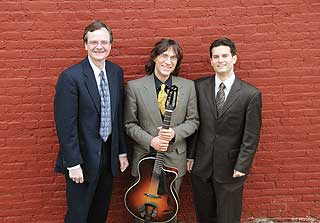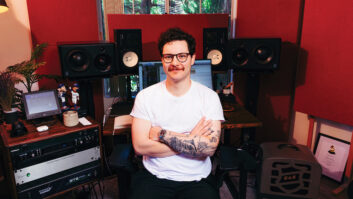
From left: stand-up bassist Gary Mazzaroppi, guitarist Frank Vignola and guitarist Vinny Raniolo
Photo: Art Wachter
New York–based guitarist Frank Vignola has tackled nearly every style imaginable during the course of a long career that has included work as a sideman for the likes of Madonna, Ringo Starr, Leon Redbone and Donald Fagen, and as a bandleader fronting his own groups, which have played everything from smooth jazz to fusion to standards. He cites influences as diverse as Pat Metheny, Frank Zappa and Wes Montgomery, and he is also known as a fine guitar teacher: Vignola has made a series of acclaimed videos sharing his broad knowledge of the instrument.
But no matter what genre Vignola explores, he never strays too long from swing music—and specifically Django Reinhardt, the highly influential French/Romani (gypsy) guitarist/composer who carved out such an important niche in the jazz world during the 1930s and ’40s. Vignola has long been considered one of the most accomplished interpreters of Reinhardt’s music, yet it wasn’t until the release of 100 Years of Django (Azica Records) that Vignola cut an entire album devoted to the music of that singular artist. (January 23, 2010, was Reinhardt’s 100th birthday; he died in 1953.)
Vignola’s 10-song CD features a mixture of well-known (“Nuages,” “Swing 49,” “Tears”) and more obscure Django compositions, including swing numbers and ballads. The songs are performed with the other members of Vignola’s regular touring trio—guitarist Vinny Raniolo and stand-up bassist Gary Mazzaroppi—and augmented by accordionist Julien Labro. Vignola’s arrangements leave plenty of room for imaginative improvisation, which takes many songs well beyond Reinhardt’s original recordings.

The session for 100 Years of Django took place in June 2009 at the First Baptist Church of Shaker Heights (Ohio), with Azica Records chief Bruce Egre handling the engineering (and later mixing and mastering). Cleveland-based Azica has been putting out audiophile-quality classical and jazz albums since the mid-’90s, building a loyal following for its recordings of everything from Beethoven Sonatas to a pair of discs by the also-Reinhardt-obsessed Hot Club of San Francisco. Egre, who also runs the Audio degree program at the Cleveland Institute of Music, describes the church where the recording took place as “a really nice-sounding room with probably a 50-foot ceiling, regular church pews, a marble floor; very ‘live’—it probably has a reverb time between two-and-a-half and three seconds. I set the musicians up right at the front of the church, down on the floor a few steps below the altar, with no isolation per se, other than the way it was miked.” Egre built a makeshift control room in a small chapel next to the main sanctuary to house his Sequoia digital recording system and ADS M-15 monitors (and Bryston amp).
He placed two mics close to each instrument: “Frank and Vinny had the same setup on each of their guitars: a TLM 170 to get the ‘body’ sound and a Coles ribbon to get more of the smooth high end. Those four mics then went through these old Telefunken V72 mic pre’s I have. I couldn’t tell you exactly how much of each mic I ended up using when I mixed it; I just sort of went for feel, depending on what they were playing. Since Frank is playing lead most of the time and he really digs in, it’s generally a different sound than Vinny.” Vignola played a (Ryan) Thorell “FV” guitar; Raniolo, a Collings SJ Indian Cutaway.
Mazzaroppi’s double bass was captured with an Audio-Technica ATM-35 and a Neumann KM 140 on the upper end. As for the accordion, Egre says, “Sound comes out of both ends—there’s sort of a high end and a low end—so even to get the overall sound you need at least a couple of mics. I used a pair of KM 140s.” Aside from the Telefunken V72s, Egre also used Millennia mic pre’s and Lavry Engineering A/D converters.
The album is essentially a live recording, “with maybe three edits in the whole thing,” Egre says. “We might have tacked on a head or an ending from a different take, but there are no overdubs at all. I put a little compression on the bass and accordion, but that’s about it.” Egre mixed the album in the Sequoia at Azica’s post facility in Cleveland, and tried to capture the essence of each instrument while also getting across the ambient sound of the church. His studio monitors were ATC 150s.
Asked if there is anything he could learn from listening to the magnificent old mono recordings that Reinhardt cut 70 and 80 years ago, Egre laughs and says, “Well, if I owned some of those old microphones, I’d be using them. There’s a certain character and quality to those old mics that is special. But that’s why, for example, I’m using the Telefunkens. There’s a character there that adds something good. But still, I’m not out to reproduce an old sound. I like having a little [ambient] space in there—that’s appealing to me. A dry old recording is just not that current. I think people today expect something different.”







